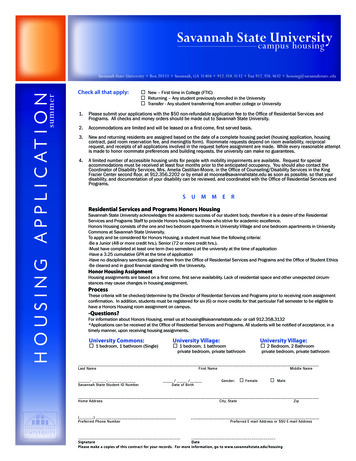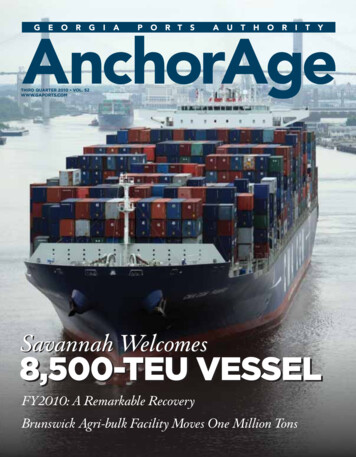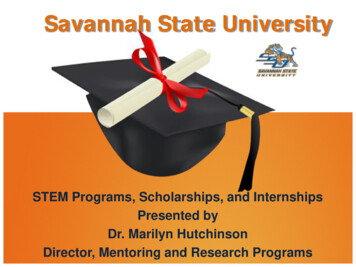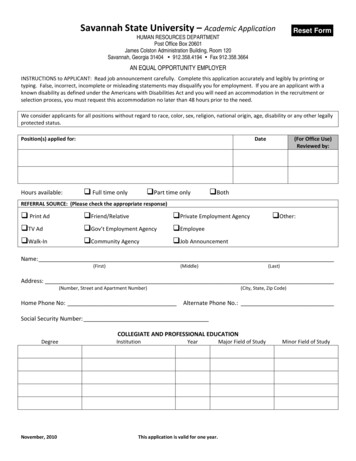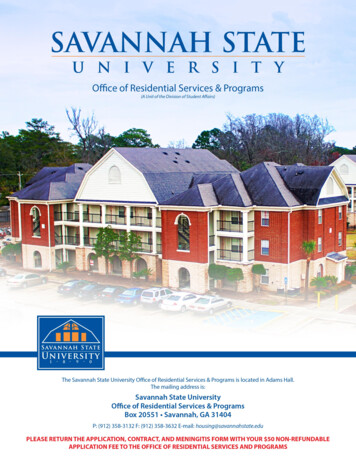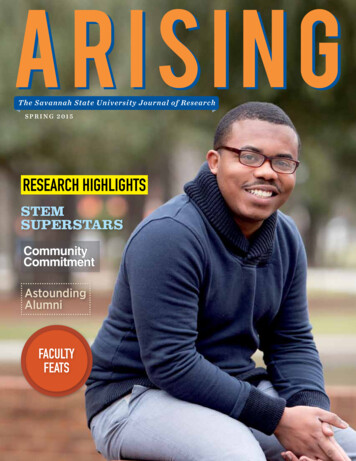
Transcription
A RISINGThe Savannah State University Journal of ResearchSPRING 2015RESEARCH ingAlumniFACULTYFEATS s ava n n a h s t a t e u n i v e r s i t y · A r i s i n g ·1
Table of Contents040608101214Lending a Helping HandSavannah State University’s Mentoring and Research Programs help studentsmeet their full potential.A Dolphin TaleStudents gain hands-on experience tracking the local dolphin population thanks toSSU’s Marine Mammal Program.Faculty Spotlight: Kai Shen, Ph.D.Kai Shen, Ph.D., an assistant professor of chemistry and forensic science, conductscutting-edge research on Alzheimer’s and cardiovascular diseases.Strengthening STEM in SavannahSSU’s Georgia Math Science Partnership grant gives middle school teachers fromthe Savannah area a unique opportunity to study on the SSU campus.SSU’s Research STARsSSU’s Minority Access to Research Careers Undergraduate Student Training inAcademic Research (MARC U-STAR) program prepares students for graduateresearch and careers in biomedical and behavioral sciences.Alumni Profile: Eric CorbettMeet alumnus Eric Corbett, a Ph.D. candidate at Georgia Tech.15How Grants Work16Service, Support, Success18202122Learn how the grant process works at Savannah State University.Expanding the number of professionally educated and trained behavioral healthclinical social work practitioners is the goal of SSU’s Master of Social Work Behavioral Health Specialization Program.Empowering the STEM Teachers of TomorrowSSU’s National Science Foundation Robert Noyce Teacher Scholarship Programprepares students to teach STEM subjects in at-risk schools.Focus on SustainabilitySSU’s College of Business Administration teaches students the importance ofsustainability.Student Voices: Devonte CliettArisingVOL. 3, NUM. 1, SPRING 2015Arising is published by University Advancement, which includesalumni relations, marketing and communications, special events, anddevelopment.S E N I O R A D M I N I S T R AT I O NC H E R Y L D. D O Z I E R , D S WPresidentC. R E Y N O L D V E R R E T, P H . D.Provost and Vice President for Academic AffairsE D W A R D B . J O L L E Y, J R .Vice President for Business and Financial AffairsP H I L L I P D. A D A M SVice President for University AdvancementF. C arl W alton, P H . D.Vice President for Student AffairsOFFICE OF SPONSOREDR E S E A R C H A D M I N I S T R AT I O NC H E L L U S . C H E T T Y, P H . D.Associate Vice President for Research and Sponsored ProgramsL inda M eierGrants ManagerA le x a S chiderAdministrative Systems ManagerARISING STAFFL O R E T T A D. H E Y W A R DMarketing and Communications/Executive EditorAMY K. PINEManaging Editor/WriterHON LOWArt Direction/Design/ PhotographyS AVA N N A H S T AT E U N I V E R S I T Y M I S S I O NSavannah State University, the oldest public historically blackuniversity in the State of Georgia, develops productive membersof a global society through high quality instruction, scholarship,research, service and community involvement. The Universityfosters engaged learning and personal growth in a student-centeredenvironment that celebrates the African American legacy whilenurturing a diverse student body. Savannah State University offersgraduate and undergraduate studies including nationally accreditedprograms in the liberal arts, the sciences and the professions.An equal opportunity/affirmative action employer accredited by theSouthern Association of Colleges and Schools (SACS). A unit of theGlobal logistics and international business major Devonte Cliett writes about hisexperience studying abroad at Nottingham Trent University in the U.K.University System of Georgia.Current Grant Funding at SSUFor more information about Savannah State University’s grantSSU has more than 40 million of active funding in 2015.www. savannahstate . eduand sponsored research programs contact: Office of SponsoredResearch Administration, Chellu Chetty, Ph.D., associate vicepresident. 912-358-4277, chettyc@savannahstate.edu, linux.savannahstate.edu/osra2· A r i s i n g · s av a n n a h s t a t e u n i v e r s i t y
Message from the PresidentSmart, Bold, Proud — SeriouslyImpressive. Those words apply toevery facet of life at Savannah StateUniversity, but they resonate especiallyloudly when we talk about our grant andsponsored research programs.Smart. Some of Savannah State’s bestand brightest students have taken part inthe university’s many grant and researchprograms. One of those former students,Eric Corbett, was a scholar in the university’s prestigious Peach State Louis StokesAlliance for Minority Participation (PSL-This year’s edition of Arising demonstrates Savannah State University’scommitment to academic excellence.The university’s academic pursuits not onlytake place in the classroom, but also in theuniversity’s many labs, on boats in Savannah’s waterways and even on the shores ofother countries.SAMP) program. Today he is working towarda Ph.D. in digital media at Georgia Tech andhas a summer internship lined up at Google.Bold. Savannah State has long beencommitted to helping those most vulnerable— the children and youth of our community.The Social Work Department’s new Masterof Social Work Behavioral Health Specialization Program grant aims to do just that bytraining talented MSW students for futurecareers as behavioral health clinical socialwork practitioners, working specifically withchildren, adolescents and transitional-ageyouth, as well as those who are at risk fordeveloping or who have a behavioral healthdisorder.Proud. SSU was the recipient of severalnew grants in the past year, among them theprestigious National Science FoundationRobert Noyce Teacher Scholarship Program,a 1.4 million award that will enable theuniversity to offer scholarships and intensive training to talented students and STEMprofessionals who are committed to teachingin our nation’s at-risk schools. When ourstudents return to the classroom as teachers,they empower the next generation of STEMscholars and make a difference in the dailylives of countless students.Seriously impressive. Savannah State’sMinority Access to Research Careers Undergraduate Student Training in AcademicResearch (MARC U-STAR) program putsunderrepresented minority students on thepath to graduate research and careers in theareas of biomedical and behavioral sciences.Savannah State’s MARC U-STAR scholarsare some of the most accomplished studentson campus and will go on to represent SSU atgraduate schools across the nation.Articles about Eric Corbett, the MSWBehavioral Health Specialization Program,the Noyce Scholarship and MARC U-STARare featured in the pages of this issue of Arising. I hope they will inspire you as much asthey have inspired me.Lab time is a crucial component to theCollege of Sciences and Technology curriculum. Professors like Kai Shen, Ph.D., anassistant professor of chemistry and forensicscience, are taking lab work to the next level.Shen, who is featured in Arising’s FacultySpotlight, was recently awarded a grant topurchase a Horiba Raman microscope, astate-of-the-art piece of equipment that willenhance the research of Shen, his colleaguesand students across campus.Savannah State’s marine sciences program is the only one of its kind in the statelocated in a natural setting, giving studentsand faculty direct campus access to themarsh, ocean and wetland areas of Savannahand the surrounding area. The university’sMarine Mammal Program, which is featuredin the pages of this publication, is just oneexample of how direct access to researchenhances student learning.Study abroad programs are an importantpart of Savannah State’s curriculum, withfaculty-led trips to various locales aroundthe world. Devonte Cliett, who is featuredin the Student Voices section of Arising,describes his experiences traveling to theU.K., where he and his fellow studentsreceived certificates in sustainability fromNottingham Trent University.The grant and research programsdescribed above and in the pages of thismagazine are the result of the hard work ofour faculty, staff and the Office of Sponsored Research Administration. SSU’smore than 40 million in current activefunding benefits the university as a whole,but most of all the students, who have theopportunity to engage their minds andexpand their horizons.Sincerely,Cheryl D. DozierPresidentSincerely,C. Reynold VerretProvost and Vice President forAcademic Affairs s ava n n a h s t a t e u n i v e r s i t y · A r i s i n g ·3
LendingAHelpingHandThe transition to college was not easy forShalyric Moye, a Dublin, Ga., native,who arrived on the Savannah StateUniversity campus in fall 2014. The freshman biology major was spending hours aday in band practice while trying to adjust tocollege life and keep up with her classes. Shealmost reached her breaking point one dayduring her Freshman Year Experience (FYE)course.“I had so much on my shoulders,” Moyesays.But before she could hit rock bottom,Moye’s FYE instructor Marilyn Hutchinson,Ph.D., stepped in and got Moye back on herfeet.“[Dr. Hutchinson] helped me get myselftogether,” Moye explains. “She became amentor and a person I could go to.”Helping students find and stay on thepath to graduation and beyond is whatHutchinson does every day as director ofSavannah State’s Mentoring and ResearchPrograms. The innovative program, whichbegan in 2012 and was restructured and4· A r i s i n g · s av a n n a h s t a t e u n i v e r s i t y relaunched in 2014, helps match studentsto grant program scholarships, organizesnetworking events with area professionals, offers shadowing programs with localcompanies and businesses, hosts workshops,helps arrange student internships, andorganizes test prep courses for graduate andprofessional school exams.Today Moye’s outlook is better than ever.She has learned how to communicate withher professors and is even applying for theuniversity’s prestigious Peach State LouisStokes Alliance for Minority Participation(PSLSAMP) program.Brittany Bush, a senior biology majorfrom Tucker, Ga., credits the Mentoring andResearch Programs with helping her securea spot as a Minority Access to ResearchCareers Undergraduate Student Trainingin Academic Research (MARC U-STAR)scholar, a prestigious program that seeks toincrease the number of minorities in behavioral and biomedical sciences.“[The program] is the reason I havea scholarship. I talk to [Dr. Hutchinson]whenever I need help with classes, to discussmy future. She helps me with career building and skill building,” says Bush, who iscurrently applying to graduate school in thearea of biomedical research.Hutchinson works alongside the programmanagers of Savannah State’s many scholarship grants, staying apprised of the latestopportunities and the requirements thatcome along with each program.Terrell Leggette, a junior electronics engineering major from Macon, Ga., is currentlyapplying for the PSLSAMP program withhelp from Hutchinson. She is also helpingLeggette explore internship opportunitiesand network with industry executives.“The [Mentoring and Research] programhas taught me that every opportunity is abusiness opportunity,” says Leggette, whorecently networked with Georgia Power executives at an event attended by Hutchinson,who serves as an education consultant for theSavannah-Chatham County Public SchoolSystem (SCCPSS) and a content expert forcurriculum support, supervision and mentor-
ing for the SCCPSS’ Career Technical Agricultural Education (CTAE) program.In addition to matching students withscholarships at Savannah State and internships at local companies, Hutchinsonoversees a successful shadowing programthat places students in local offices to workwith industry-specific professionals overthe course of a semester. She currently hasshadowing programs in place for students interested in the fields of medicine,electronics engineering and education.For many of the students in the shadowing program, the experience has been theironly opportunity for authentic engagementin their field of interest.Hutchinson is also fostering partner-ships with other universities to give SSUstudents additional opportunities to expandtheir educational horizons. Savannah Staterecently signed a Memorandum of Understanding with North Carolina State University (NCSU) that will guarantee five SSUstudents slots in the university’s graduateprogram, while NCSU will send some of itsstudents to Savannah State. The program,which will be run by SSU’s graduate studiesoffice, is just one example of how the Mentoring and Research Programs seek to helpstudents succeed on the campus of SavannahState and beyond.But one of the greatest resources theMentoring and Research Programs offer isHutchinson herself.“I want students to find out what theyreally want to do in life or to realize that theywant to go in a different direction. Beforeyou invest a lot of time and a lot of money,it’s important to be exposed to a field,” saysHutchinson, who personally drives studentsto their internships if they can’t find theirown transportation. “I want students toknow that there’s an office here that caresabout them.”p Marilyn Hutchinson, Ph.D., (center), director ofSSU’s Mentoring and Research Programs, advisesstudents across campus, including (from leftto right) freshman Shalyric Moye, junior TerrellLeggette and senior Brittany Bush.s ava n n a h s t a t e u n i v e r s i t y · A r i s i n g ·5
y6Student interns in SSU’s Marine Mammal Program spend time on the water and in the lab.(Clockwise from top) Cody Rigney, a juniormarine sciences major, studies distributionof dolphins. Associate Professor of MarineSciences Tara Cox, Ph.D., is director of theMarine Mammal Program. Rachael Randall, agraduate student in marine sciences, spendstime in the lab analyzing dolphin blubberfor stable isotope ratios. Cassandra Harris, asophomore marine sciences major, is workingto reassess human interaction rates of bottlenose dolphins.· A r i s i n g · s av a n n a h s t a t e u n i v e r s i t y
A DOLPHIN TALEWhen a dolphin washed ashore on Tybee Islandin early February, it could have been anotherheart-wrenching tale of an animal meeting atragic end. But thanks to Savannah State University’sMarine Mammal Program, the death of the bottlenosedolphin known as Phineas will become a teachablemoment.Led by Tara Cox, Ph.D., an associate professor ofmarine sciences, the Savannah State Marine Mammal Program had been tracking Phineas since 2009.The program is funded through several grants at theuniversity, including the Title VII, National ScienceFoundation Enhancing Diversity in Geoscience Education (EDGE), Bridge to Research in Marine SciencesResearch for Undergraduates (REU) and StudentsEngaged in Naval STEM Research (SENSR) programs,among others.Eleven undergraduate and three graduate studentsfrom the various grant programs currently serve asinterns in the Marine Mammal Program. The studentsassist faculty with tracking the local dolphin populationin Savannah-area waterways, then map their resultsback in the SSU Dolphin Sciences Lab.The SSU Marine Mammal team had spotted Phineasat least 16 times over the past five years, tracking theadventurous mammal as he swam around Tybee Islandand up and down the Bull River.Beachgoers found Phineas’ body on Tybee’s northbeach and contacted local authorities. The GeorgiaDepartment of Natural Resources was called in and performed the necropsy with assistance from SSU studentsand staff. The DNR then shared the deceased dolphin’spicture to its local stranding network, of which Savannah State is a part.“When they did the necropsy, the dorsal fin was inreally good shape,” explains Cox. “We identify animalsby unique patterns of nicks and notches on their dorsalfins. My lab manager Robin Perrtree immediately recognized that it was one of our animals.”Cox hopes that the lab results from Phineas’ necropsy will shed some light on why the dolphin was soemaciated and sickly when he washed ashore. Thesamples taken during the necropsy are currently beingtested for a variety of illnesses including brucellosis, abacterial infection, and morbillivirus, an illness similarto the human form of measles.While disease may have been the cause of Phineas’death, other dolphins in the area face challengesbrought on by humans. Through their research, Cox andher team have discovered that the Savannah area hasthe world’s worst begging problem.“We see dolphins begging about two-thirds of ourdays on the water and about a quarter of our sightings,”explains Cox, who developed five metrics to comparedolphins in the Savannah area to those in other dolphinhotspots around the world.Begging poses a danger to dolphins, which are atrisk for injury when they swim so closely to boats. Thehuman snacks that boaters often feed dolphins can alsoharm the popular mammals.Cassandra Harris, a sophomore marine sciencesmajor from Stone Mountain, Ga., is currently working inthe Marine Mammal Program to reassess human interaction with the local bottlenose dolphin population,updating research that was conducted by Perrtree overthe last several years. Harris, who has been intriguedby dolphins since she visited Sea World as a child, ischronicling the number of begging events per sightingand per day, as well as the number of human interactions per sighting and per day.Harris’ research will help Cox and her team understand the extent of dolphin-human interaction in thearea.“My ultimate goal is to affect policy with our science,”says Cox, explaining that members of the NationalOceanic and Atmospheric Administration came toSavannah a few years ago to observe the waterways andconduct outreach.Cox and her team also regularly visit schools and talkto local fishermen in hopes of discouraging people fromfeeding dolphins.“It looks like there has been a slow decline [in begging],” Cox says. “It’s hard to say why, but we’re gettingnews articles out, we’re doing outreach and there’s beensome enforcement. That may be making a difference.”Harris’ research will be presented at a conferencethis spring and will be an important step in addressingand understanding the issues facing the local population, something that will help protect dolphins likePhineas for years to come. s ava n n a h s t a t e u n i v e r s i t y · A r i s i n g ·7
KAISHENFacultySpotlightPh.D.Kai Shen, Ph.D., makes a difference inthe lives of students every day on thecampus of Savannah State University,inspiring the young scientists to engagein research that could change the world.Thanks to a trio of grants, Shen, an assistantprofessor of chemistry and forensic science,is exposing his students to cutting-edgeresearch in the areas of Alzheimer’s andcardiovascular diseases.In 2013, Shen, who received a Ph.D. inchemistry from the New Mexico Institute ofMining and Technology, was awarded a StepsToward Academic Research (STAR) Fellow-8· A r i s i n g · s av a n n a h s t a t e u n i v e r s i t y ship from the University of North Texas’(UNT) Texas Center for Health Disparities.As part of the program, Shen traveled to theUNT campus every other month to receiveextensive training on health disparity issues,community-based research methodologiesand grant development.Shen was paired with Meharvan Singh,Ph.D., an established scientist at the UNTcampus, who inspired him to become passionate about disparity issues of Alzheimer’sdisease in minority populations. UnderSingh’s mentorship, Shen and SSU colleague Karla-Sue Marriott, Ph.D., associateprofessor of chemistry and forensic science,prepared a preliminary proposal to studythe role of the brain’s sigma-1 receptor in theprogression of Alzheimer’s disease.At the end of his fellowship, Shensubmitted their work to the Texas Centerfor Health Disparities, which selected theproposal for a peer-reviewed Pilot Projectaward. This 10,000 seed grant supportsShen’s ongoing research efforts at SSU tocorrelate sigma-1 receptor structure withits roles in the progression of Alzheimer’sdisease. Shen serves as the Pilot Project’sprincipal investigator (PI), with Marriott
and Singh serving as co-PIs. The team utilizes several student interns at SSU, who alsoassist with the research efforts.Shen’s research on the sigma-1 receptorwill be enhanced further thanks to a secondgrant he received in October 2014 from theU.S. Department of Defense/Army ResearchOffice. The 331,997 grant, which is part ofthe Department of Defense Research andEducation Program for Historically BlackColleges and Universities and MinorityServing Institutions, enabled the universityto purchase a top-of-the-line Horiba Ramanmicroscope.“It is the onlyRaman microscopewith an ultra violetlaser in the coastalGeorgia region,”says Shen. “Theultra violet Ramanwill provide a veryunique capabilityto analyze how theprotein structurechanges. Thisinformation can’tbe extracted byother analyticaltechniques. We’revery fortunate tohave it.”Shen plans touse the high resolution microscope,which will be installed in a dedicated labin the Drew-Griffith science building thisspring, to analyze the function of the sigma-1receptor in Alzheimer’s, using compoundscreated by his colleague Marriott. His goalis to see how the compounds can be used totreat the disease.Shen serves as the grant’s PI, along withfour co-PIs: Christopher Hintz, Ph.D.,associate professor of marine sciences;Hua Zhao, Ph.D., associate professor andchair of chemistry and forensic science;Paramasivam Sivapatham, Ph.D., associateprofessor of environmental science; andMarriott. Shen and his co-PIs will utilize themicroscope to conduct research in the areasof marine sciences, chemistry, engineering,biology and forensic science and will also usethe high-tech instrument as a teaching toolfor students.“It’s a benefit for students engaging inresearch and for teaching efforts,” Shenexplains. “We have designed 11 upper-levelcourses that will involve the microscope,and we estimate that every year, around 160students will have access to the instrument.”In addition to his work with Alzheimer’sdisease, Shen is also focusing his researchefforts on a disease that disproportionatelyaffects minorities: hypertension. In January2015, Shen received a 296,692 grant fromthe National Institutes of Health Support ofCompetitive Research (SCORE) Program toinvestigate the role of the metavinculin protein in mediating crosstalk between vascularsmooth muscle cells (VSMCs) and extracellular matrix (ECM). VSMCs and ECM havebeen found to contribute to aortic stiffness,which causes hypertension — a main riskfactor in cardiovascular disease.“Cardiovascular disease is very deadly,killing, based on CDC data, roughly 600,000folks a year. One of the biggest risk factors is hypertension. We want to find outhow hypertension leads to cardiovasculardisease, but we don’t know the mechanism,”Shen explains.Shen’s ultimate goal is to create effectiveinterventions against hypertension development and reduce cardiovascular-relatedmortality by revealing vascular remodelingmechanisms.To help with the research phase of thegrant, Shen has enlisted student interns,who are paid to assist him in the lab.“We want to inspire students and getthem involved in STEM research, especially biomedical research,” says Shen, whohopes his studentinterns will goon to completegraduate studiesin STEM-relatedfields. “It’s ourhope to increasethe population ofminority studentsin the biomedicalfield.”Despite hissuccess in securing three grantsin such a shortperiod of time,Shen, who joinedSSU in 2012 as anassistant professor after completing post-doctoralwork at theUniversity of North Carolina at Chapel Hill,remains humble, praising Savannah Stateand its many faculty and staff members forhelping facilitate his endeavors.“There are synergetic efforts acrosscampus. This is teamwork,” Shen says. “I’mblessed to have so much help from so manyfolks.”p Kai Shen, Ph.D., (left) works with interns in hislab, including (from left to right) Eddie Gontee, asenior biology major from Atlanta, and ChristianLyle, a junior biology major from Savannah, Ga.,both of who assist Shen with his cardiovascularresearch, and Sakura McLaughlin, a junior biology major from Savannah, Ga., who assists Shenwith his Alzheimer’s research.s ava n n a h s t a t e u n i v e r s i t y · A r i s i n g ·9
Strengthening STEMin SavannahSavannah State University’s College ofSciences and Technology (COST) istasked with overseeing the education ofnearly 1,500 students majoring in STEMrelated disciplines on campus. Now thousands more students from the Savannah areawill benefit from the knowledge of COST’sesteemed faculty thanks to the Georgia MathScience Partnership (MSP) program.MSP is a statewide initiative that seeksto improve teacher quality and increasethe academic achievement of students inthe areas of mathematics and science bycreating partnerships with state agencies,institutions of higher education, high-needlocal education agencies and schools.Savannah State’s 448,000 grant, fundedby the Georgia Department of Education,will enable the university to create a two-10· A r i s i n g · s av a n n a h s t a t e u n i v e r s i t y year professional development programfor middle school science teachers. Theprogram, which is a partnership betweenSavannah State and the Savannah-ChathamCounty Public School System (SCCPSS),will equip the teachers with the skill set andtools necessary to effectively teach scienceto grades 6-8.During the program, 48 SCCPSS andEffingham County School System teachers,along with two teachers from area privateschools, will come to the Savannah Statecampus during the summers of 2015 and2016 to participate in an intensive two-weeksummer session.“We’re working with those schools thatare in the most need in terms of students’skills and abilities in science,” says JonathanLambright, Ph.D., COST dean and the grant’sproject director.Lambright and his team used CRCTscores as a basis for determining the mostneedy schools, ultimately selecting eightSCCPSS schools, among them Mercer,Myers, DeRenne, Hubert, East Broad Street,West Chatham, Isle of Hope and Southwestmiddle schools.During the summer session, eight facultymembers from COST and SSU’s School ofTeacher Education will work with the teachers to introduce STEM topics in the areasof earth science, life science and physicalscience. In addition to learning about topicssuch as hydrology and meteorology, evolution, and energy and its transformation, theteachers will be exposed to new and innovative methods of content delivery.The teachers, who will receive a stipend
tfor their participation in the program, willalso attend follow-up sessions throughoutthe subsequent academic year, completing atotal of 100 hours of instruction.Lambright is working with SavannahState colleagues including Co-ProjectManager Patrick Dean and Coordinator ofCurriculum Development Alex Kalu, Ph.D.,professor of civil engineering, along withSCCPSS Chief Academic Officer Ann Levett,Ed.D., and Program Manager for ScienceHolly Rutledge to develop the innovativecurriculum.Levett says that the high-quality professional learning experience teachers receiveduring the course of the program will prepare them further to implement college andcareer-readiness standards effectively.“Our classrooms and schools are increas-(Left) College of Sciences and Technology DeanJonathan Lambright, Ph.D., serves as the Georgia MathScience Partnership’s (MSP) project manager. (Oppositepage, left) Middle school science teachers Veronica Smithfrom Mercer Middle School (left) and Helen Ward fromEffingham County Middle School (right) are two of 50area teachers participating in the MSP program this summer. (Opposite page, right) Teachers and members ofthe MSP team pose in front of Hill Hall after signing theircontracts of participation in the summer 2015 program.higher education.“Important concepts of science andmathematics start as early as elementary andmiddle school. Everything builds upon that,”says Lambright, noting that students whodon’t learn those concepts early on are at riskfor falling behind in high school and college.“The students that we’re trying to reachnow will ultimately appear at the doorstepsof Savannah State, as well as other areainstitutions of higher education,” Lambright says. “In the nation there’s an issue ofstudents not being prepared in science andmathematics, and this is our opportunity totry to reverse that trend and tighten the tiesbetween institutions of higher educationand the public school system so that whenthe students come to us, they’re preparedand ready to take college-level classes.”ingly filled with a more diverse student body— race, class, ethnicity, ability and culture.As expectations for positive student performance outcomes increase, considerablymore students may have challenges meetingthose higher-level expectations, especiallyin the areas of science and mathematics,”Levett says. “Through this Math and SciencePartnership effort, our district’s teacherswill receive intensive, content-rich professional development, with the goal of improving classroom instruction and, ultimately,student achievement in math and science.”Lambright is confident that the MSPprogram will be a success and believesthat the initiative will not only benefit themiddle school teachers and their studentsbut will also have a positive impact onSavannah State and other institutions of s ava n n a h s t a t e u n i v e r s i t y · A r i s i n g ·11
SSU’s RESEARCH STARsWhile many of their classmates enjoyedsome well-earned time off last summer, Mandisa Taqqee and BrittanyBush spent their vacation in the lab. Taqqee,a senior biology major from Los Angeles,worked in the neuroscience departmentof the University of California, Los Angeles, studying transcription factor FoxP2, aprotein in humans that is linked to speechdevelopment. Bush, a senior biology majorfrom Tucker, Ga., headed to the Universityof California, Davis, where she conductedresearch in the college’s physiology
2 · Arising · savannah state university Lending a Helping Hand savannah state university's Mentoring and research Programs help students meet their full potential. A Dolphin Tale students gain hands-on experience tracking the local dolphin population thanks to ssu's Marine Mammal Program. Faculty Spotlight: Kai Shen, Ph.D.



